In recent years, silent discos have emerged as a transformative trend in the global music scene, offering a novel way for people to experience live music and entertainment. Unlike traditional events where music blares from large speakers, silent discos provide participants with wireless headphones, allowing them to dance to music only they can hear. This innovation has reshaped how we engage with music, blending technology, individuality, and social interaction in creative ways.
Origins of Silent Discos
The concept of silent discos originated as a solution to noise restrictions at events. Notably, during the 1994 Glastonbury Festival, organizers provided attendees with headphones connected to an on-site radio station, enabling them to enjoy music without disturbing nearby residents. This approach addressed complaints about evening noise levels and offered a unique festival experience. The popularity of silent disco events grew over the years, with BBC Music holding their own silent gig in Cardiff.
How Silent Discos Work
At a silent disco event, participants receive wireless headphones connected to one or more music channels. DJs perform live, and attendees can switch between channels to choose the music that suits their mood or taste. Each channel typically corresponds to a different genre or DJ, offering an array of musical styles at the same event. This setup creates a dynamic experience where people in the same space dance to different beats, yet still share a collective atmosphere.
Why Silent Discos Are Gaining Popularity
Several factors contribute to the growing appeal of silent discos:
Personalized Music Experience: Unlike conventional concerts where everyone hears the same sound, silent discos allow each attendee to tailor their experience. With the ability to switch between multiple music channels and control volume levels, participants can enjoy a variety of genres at the same event, making the experience comfortable for everyone.
Interactive and Social Environment: Despite everyone wearing headphones, silent discos foster a unique social dynamic. Participants often find humor in the sight of people dancing to different beats, sparking curiosity and camaraderie. Groups of friends can switch between channels together or choose different ones and compare their experiences, adding to the fun. Since communication is easy—just remove the headphones to talk—silent discos encourage interaction in a way that traditional, loud music venues do not.
Versatility for Venues and Events: Silent discos are incredibly versatile and can be held virtually anywhere, from indoor venues and rooftops to beaches, parks, or even residential areas where noise restrictions apply. Because the music is confined to the headphones, silent discos don’t disturb the surrounding area, making them ideal for urban locations or outdoor events that need to comply with noise regulations. This versatility extends beyond venue choices; silent discos are also popular at various types of gatherings, such as weddings, corporate events, fitness classes, and even yoga retreats.
Technological Advancements: Modern wireless headphone technology allows for high-quality sound transmission over long distances with minimal interference. Advances in Bluetooth technology and multi-channel systems have made it easier for events to offer several music options simultaneously. With the ability to stream from live DJs or pre-recorded playlists, the experience feels just as immersive as a traditional event while adding layers of personalization.
Cultural Impact and Future Prospects
Silent discos have transcended their initial purpose of addressing noise complaints to become a cultural phenomenon. They offer a unique blend of personal choice and collective experience, appealing to a wide range of audiences. As technology continues to evolve, silent discos are likely to become even more immersive and accessible, further solidifying their place in the future of live entertainment.









